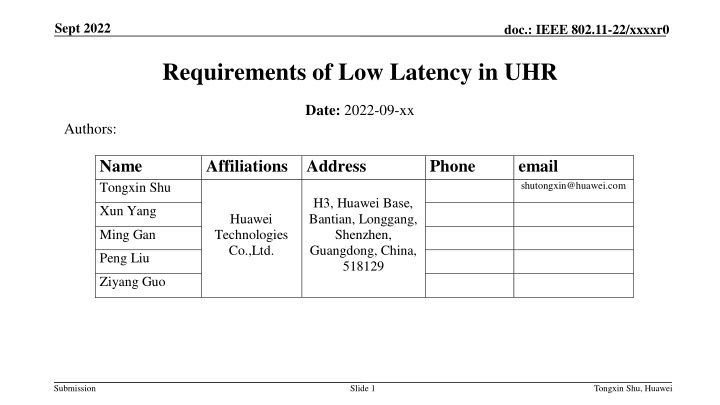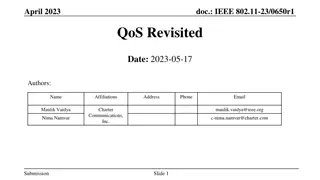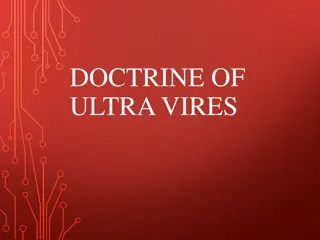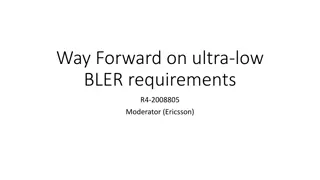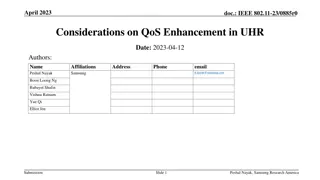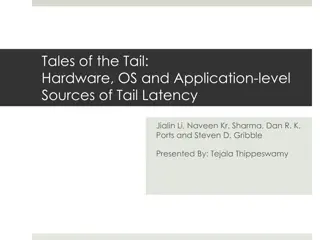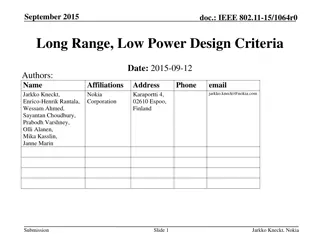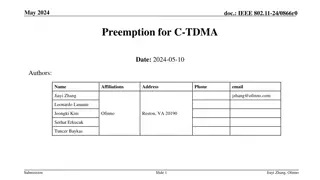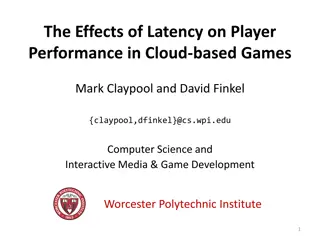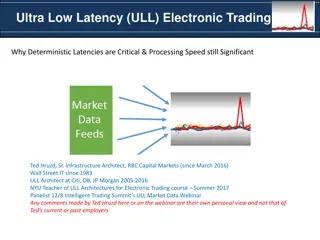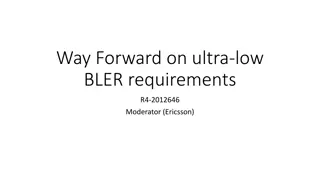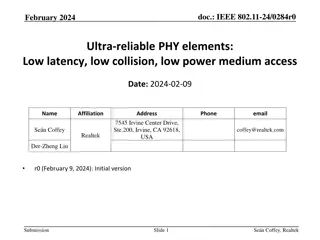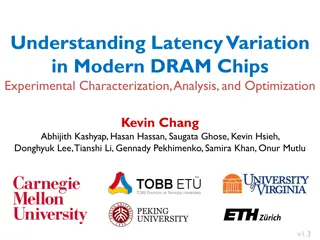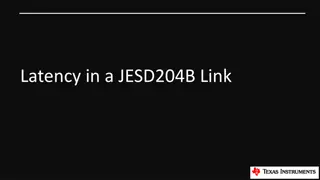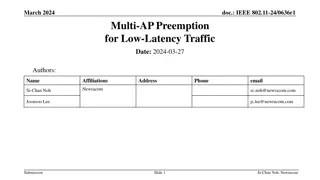Low Latency Requirements in Ultra-High Rate Communication
This document discusses the requirements and use cases of low latency in ultra-high rate communication scenarios, highlighting applications such as metaverse, cloud gaming, real-time video streaming, in-vehicle infotainment, and industrial PLC control. It also covers current methods to reduce latency, including Multi-link operation (MLO), optimized CSMA/CA, restricted TWT, traffic shaping, and load balancing techniques. A case study comparing latency performance between 11ax and 11be technologies is presented to illustrate latency reduction possibilities.
Download Presentation

Please find below an Image/Link to download the presentation.
The content on the website is provided AS IS for your information and personal use only. It may not be sold, licensed, or shared on other websites without obtaining consent from the author.If you encounter any issues during the download, it is possible that the publisher has removed the file from their server.
You are allowed to download the files provided on this website for personal or commercial use, subject to the condition that they are used lawfully. All files are the property of their respective owners.
The content on the website is provided AS IS for your information and personal use only. It may not be sold, licensed, or shared on other websites without obtaining consent from the author.
E N D
Presentation Transcript
Sept 2022 doc.: IEEE 802.11-22/xxxxr0 Requirements of Low Latency in UHR Date: 2022-09-xx Authors: Name Tongxin Shu Affiliations Address Huawei Technologies Co.,Ltd. Phone email shutongxin@huawei.com H3, Huawei Base, Bantian, Longgang, Shenzhen, Guangdong, China, 518129 Xun Yang Ming Gan Peng Liu Ziyang Guo Submission Slide 1 Tongxin Shu, Huawei
Sept 2022 doc.: IEEE 802.11-22/xxxxr0 Use Cases of Low Latency Low latency use cases have been discussed in [1]: Metaverse VR/AR Cloud gaming Real-time video streaming In-vehicle infotainment Tactile signals Industrial PLC control P2P links(distributed sharing/operation between devices) Submission Slide 2 Tongxin Shu, Huawei
Sept 2022 doc.: IEEE 802.11-22/xxxxr0 Use Cases of Low Latency Latency requirements of some use cases: Use Cases Equipment Application Specification Delay Requirement Bandwidth P2P Screen Sharing Cloud-based Gaming Web Conference Sink:PC/Pad/Avatar/Large Screen/Car Source: Phone/Pad/PC <10ms@95% <100ms@99.99% ~25Mbps@2K ~50Mbps@4K Real-time Video Streaming <4ms@95% <40ms@99.99% ~2Mbps Reverse haptic control Real-time Control Messaging P2P Hardware Control (Keyboard/Mouse sharing) <4ms@95% <40ms@99.99% ~400Kbps Keyboard and mouse feedback Autonomous driving/Traffic safety control / 10ms-20ms[23] V2X Vehicle Submission Slide 3 Tongxin Shu, Huawei
Sept 2022 doc.: IEEE 802.11-22/xxxxr0 Current Methods to Reduce Latency Increasing contention opportunity Multi-link operation(MLO), optimized CSMA/CA [2] or EDCA parameters [3] and restricted TWT [4] Traffic shaping: prioritize critical applications while delaying less significant data packets [5] Reducing number of contentions among STAs parallel transmission (OFDMA, MU-MIMO, Spatial reuse [6]) subgrouping: break the network down into smaller, more frequently communicated groups load balancing: distribute incoming network traffic over several servers on the backend [7] Submission Slide 4 Tongxin Shu, Huawei
Sept 2022 doc.: IEEE 802.11-22/xxxxr0 Current Methods to Reduce Latency Take MLO for an example, it is promising way to improve latency performance [8] The simulation setup assumes 5 BSSs are using the same channel, where there is 1 AP or AP MLD within each BSS. In 11ax, each AP is associated with 4 STAs, while in 11be, each AP MLD is associated with 4 non-AP MLDs. The simulation results show that the latency of 11be is reduced around 32% compared to that of 11ax. Our Uplink OFDMA Downlink OFDMA Submission Slide 5 Tongxin Shu, Huawei
Sept 2022 doc.: IEEE 802.11-22/xxxxr0 Analysis of WLAN latency However, all of current methods can t address the delay issue resulted from channel access Channel access become the bottleneck of latency performance improvement Delay due to Channel access/collision Packets may be sent at irregular intervals due to the fact that multiple users are accessing the channel simultaneously and collision happens A higher collision probability will likely result in a higher average delay [9][10] The delay is highly affected by the CSMA/CA scheme with different mechanisms [11] When the traffic is saturated, the delay is highly affected by initial window size, maximum number of backoff, and the CSMA w/ or w/o RTC-CTS An increased number of users results in a higher collision probability and delay Submission Slide 6 Tongxin Shu, Huawei
Sept 2022 doc.: IEEE 802.11-22/xxxxr0 Analysis of WLAN latency Jitter due to Channel access/collision As discussed in [12], the channel access scheme has an overwhelming impact on the jitter. Theoretically, jitter can be derived as the function of contention window, station number and packet length [13]. The minimum jitter can be obtained by tuning the contention window for given network size and packet length. It implies that the jitter cannot be lower than certain value via any optimization w.r.t. CSMA/CA parameters. The jitter increases as the station number increases given different initial window size and maximum number of backoff Submission Slide 7 Tongxin Shu, Huawei
Sept 2022 doc.: IEEE 802.11-22/xxxxr0 Latency Performance Improvement with AI/ML Deep reinforcement learning(DRL) for optimizing contention window [14][15] This deep learning scheme could always find the optimal CW adjustment multiple by adaptively perceiving the channel competition status. The finalized performance of the model has been significantly improved in terms of system throughput, average transmission delay, and packet retransmission rate Submission Slide 8 Tongxin Shu, Huawei
Sept 2022 doc.: IEEE 802.11-22/xxxxr0 Latency Performance Improvement with AI/ML Machine learning based congestion control strategy for reducing latency [16] Based on the proposed DNN model, this contention window adaptation algorithm is able to deliver consistently higher average throughput, lower end- to-end delay, as well as improved fairness Slide 9 Submission Tongxin Shu, Huawei
Sept 2022 doc.: IEEE 802.11-22/xxxxr0 Conclusion Lots of works have been done to improve latency while CSMA/CA is still the bottleneck of the latency performance Machine learning techniques have shown effectiveness in reducing latency by studying the dynamic characteristics of the WLAN We propose to use AI/ML techniques to further improve the latency performance Submission Slide 10 Tongxin Shu, Huawei
Sept 2022 doc.: IEEE 802.11-22/xxxxr0 References [1] 11-22-0723-00-0wng-further-discussion-on-next-generation-wlan [2] 11-22-0979-01-aiml-applying-ml-to-802-11-current-research-and-emerging-use-cases [3] Serrano P, Banchs A, Patras P, et al. Optimal configuration of 802.11 e EDCA for real-time and data traffic[J]. IEEE Transactions on Vehicular Technology, 2010, 59(5): 2511-2528. [4] Adame T, Carrascosa-Zamacois M, Bellalta B. Time-sensitive networking in IEEE 802.11 be: On the way to low-latency WiFi 7[J]. Sensors, 2021, 21(15): 4954. [5] Georgiadis L, Gu rin R, Peris V, et al. Efficient network QoS provisioning based on per node traffic shaping[J]. IEEE/ACM transactions on networking, 1996, 4(4): 482-501 [6] de Carvalho Rodrigues E, Garcia-Rodriguez A, Giordano L G, et al. On the Latency of IEEE 802.11 ax WLANs with Parameterized Spatial Reuse[C]//GLOBECOM 2020-2020 IEEE Global Communications Conference. IEEE, 2020: 1-6. [7] Dhakal S, Hayat M M, Pezoa J E, et al. Dynamic load balancing in distributed systems in the presence of delays: A regeneration-theory approach[J]. IEEE transactions on parallel and distributed systems, 2007, 18(4): 485-497. [8] 11-22-1348-00-00be-lb266-cr-for-par-verification-low-latency [9] Tickoo, Omesh, and Biplab Sikdar. "Modeling queueing and channel access delay in unsaturated IEEE 802.11 random access MAC based wireless networks." IEEE/ACM transactions on networking 16.4 (2008): 878-891. [10] Zhai, Hongqiang, Younggoo Kwon, and Yuguang Fang. "Performance analysis of IEEE 802.11 MAC protocols in wireless LANs." Wireless communications and mobile computing 4.8 (2004): 917-931. [11] Ziouva, Eustathia, and Theodore Antonakopoulos. "CSMA/CA performance under high traffic conditions: throughput and delay analysis." Computer communications 25.3 (2002): 313- 321. [12] Huang, Ching-Ling, and Wanjiun Liao. "Throughput and delay performance of IEEE 802.11 e enhanced distributed channel access (EDCA) under saturation condition." IEEE Transactions on wireless communications 6.1 (2007): 136-145. [13] Dai L, Sun X., A Unified Analysis of IEEE 802.11 DCF Networks: Stability, Throughput, and Delay , IEEE Transactions on Mobile Computing, Vol. 12, No. 8, 2013 Submission Slide 11 Tongxin Shu, Huawei
Sept 2022 doc.: IEEE 802.11-22/xxxxr0 References(cont d) [14] Chen C, Li J, Balasubramaniam V, et al. Contention resolution in Wi-Fi 6-enabled internet of things based on deep learning[J]. IEEE Internet of Things Journal, 2020, 8(7): 5309- 5320. [15] Edalat Y, Obraczka K. Dynamically Tuning IEEE 802.11's Contention Window Using Machine Learning[C]//Proceedings of the 22nd International ACM Conference on Modeling, Analysis and Simulation of Wireless and Mobile Systems. 2019: 19-26. [16] Taherkhani, Nasrin, and Samuel Pierre. "Centralized and localized data congestion control strategy for vehicular ad hoc networks using a machine learning clustering algorithm." IEEE Transactions on Intelligent Transportation Systems 17.11 (2016): 3275-3285. Submission Slide 12 Tongxin Shu, Huawei
